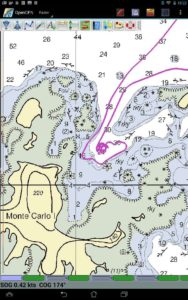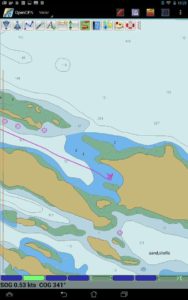Sumner Strait, Heading east against the current, 16-AUG-2018 — I never come below when we’re underway. My days are spent in the cockpit watching the world go by, when we’re under power, or sailing, when there is wind. Fixing the autohelm for long periods doesn’t work on the inside passage, the straits are too narrow, and the water has too many floating obstacles.
Yesterday, we spent the morning in Lord’s Pocket. Jennifer has a new kelp-of-Alaska book, which she bought at the ranger station in Glacier Bay, that she wanted to identify kelp with. We launched our Portland Pudgy dinghy, Hilary Hoffmann, from the deck. We’ve been thinking, and I have been writing, about the changes in our perspective as we become practiced and the adventure turns into everyday life.
We launch the dinghy by attaching the jib halyard to a bridle on the transom of the dinghy. After unstrapping the dinghy, untying it from the bow pulpit and releasing the life lines, I crank the dinghy close to vertical using the halyard winch. This is when I notice that I am aging. I’ve become very sensitive to hydration. Dehydrated and it is a difficult crank. Well hydrated and the handle goes round and round.
Once near vertical, Jennifer, who is standing in bow pulpit turns the dinghy right side up, and pushes it over the side. I slowly release the halyard and the Hilary Hoffmann slides into the water. The dinghy has a wheel at the aft end of its two-inch deep keel. The wheel rolls along the hull as the dinghy descends into the water.
Usually, I am first into the dinghy to remove the disassembled oars from storage in the hull. Today Jennifer does, while I get something or other from down below in Caro Babbo.
When we were here in the spring, Jennifer rowed ashore to the thread of isthmus that connects the two islands. The gravel side facing us was light colored, with a lava black top. Last evening, we watched the isthmus disappear under the water; our anchorage looked exposed from two sides. This morning it is a zero tide. Islands have risen to the west. To the east the isthmus is twenty feet high.
Jennifer sits on the transom seat. I flip my seat forward to compensate for her weight and begin to awkwardly row, until I noticed we placed, Jennifer placed one oar I placed the other, in the aft oar locks. We drift while we re-place the oars.
Ashore, the landing is barnacle-covered soccer-ball-sized rocks. We each step over the side into water half the depth of our Xtra-Tuff boots (called Alaska Sneakers by many) and pull the dinghy a small distance up the beach. The tide is still receding, so the dinghy will be farther from the water when we return.
Jennifer takes her book and starts examining the kelp. She complains that the book identifies kelp solely by its leaves, not its hold-fast or other structures. She quickly becomes distracted by the rock formations, which are black slate-like millefeuil with eroding-away layers of a light material. In some places, the layers are individual but there is no space for material to be missing between the layers.
Jennifer explains that the layers twisted and heaved before rotating so that the once horizontal layers are now vertical and irregular. It is Alaska at it geographic best: a puzzle of millenniums and eons. Scattered across the terrain like meat balls on a pizza are bolders that have no business being with this black lava. They have been left here by glaciers. It is a moonscape surrounded by dense pine woods.
On the far side of the isthmus, a mother river otter with two pups swim and play together, coming in an out of the water without regard for us.
While Jennifer stands next to me, movement catches my eye. A mink is running with a crab in its mouth from the shore on our left to the woods on our right.
An eagle sits in a tree a distance away but out of line of sight. I think of predator becoming prey and Springsteens Jungleland, ”the hunter and the hunted.”
A crow flies overhead and the mink drops the crab and bolts for cover in the greenery near the woods. I think to myself that the mink doesn’t bother check whether the bird is a predator.
After a moment, the mink cautiously returns for the crab. As the mink walks back to the woods, the crow spots the mink and darts towards it. It is clear that the crow wants the crab. The mink knows this and runs for the shadow of a large bolder. The mink does its best to keep the bolder between itself and the crow as the crow stays airborne trying to flush out the mink.
The opportunity arrives and the mink makes a run for the greenery. The crow lands, but is too slow and the mink takes the crab into the tall grass. The crow on the ground won’t enter where it can’t spread its wings. It caws loudly in frustration, but after a few moments flies off.
The otters in the water have continued being otters without regard to the failed thievery up the beach.
After we leave Lord’s Pocket we must travel through Rocky Pass from north to south. We’ve done south to north twice before, in late May and early June, but now in August the kelp has being thriving in the sun for two months.
The standard wisdom is to arrive at the summit just before slack and pass through Devil’s Elbow* at slack — no current. But Jennifer decides that she has enough experience to arrive early and allow two knots of current to push us through.
[Please keep in mind that on a high school trip, from a canoe, Jennifer poked a bull alligator with a paddle to make it move.]
Rocky Pass is choked with kelp in places. We pick up some big leaves of bull kelp on the prop that cause us to lose speed and makes a sound like bearing going bad as it cavitates. But unlike stringy kelp, the leaves will untangle if we reverse the prop or they will just disintegrate in time. We still have my wetsuit in the cabin drying from Auke Bay when I ”dived on” our prop to remove a bull kelp stem that wrapped around the prop and shaft.
We reverse a few times. Sometimes to untangle kelp, other times because we’re not certain why we’ve lost speed.
At both the summit and Devil’s Elbow, I make a Securité call. We see no one on AIS and suspect we are alone, but as we dodge kelp in the elbow, we see a small power troller coming towards us. He makes no call and may not have had his radio on to hear us. He knows what he is doing and picks a practiced course through.
We dodge more kelp and make an anchorage in a hollow of islands that is seemingly exposed on three sides and appears in none of the guide books. It has been recommended to us by Heath Snows. It is clear that if the wind stays from the south, it will be safe and protected. Exposed as it is means the views are unimpeded across now-flat water.
The chart says the bottom is rock, so I attach a trip line to the anchor using a fendor as a float. In the morning, we will discover the bottom is mud with good holding.
Despite the weather forecast there has been no wind. We’ve motored all day, which gave me the opportunity to make a tomato sauce using the Italian sausage I bought in Juneau. We’ve been out of ice for days, so it was time to get it used. (Kroger uses so little, if any, fennel in sausages that I suspect they are italian solely because they attached a label that said so. They also grind the meat close to forcemeat, but then one should not know how laws and sausages are made.)
Because dinner was ready, Jennifer and I were able to have a heart-to-heart about the future and what we each want. We reaffirmed our commitment, which we hadn’t done in a while, and laid out how we will proceed forward. This may not be a ten-year adventure as planned, or perhaps the pace will change, or perhaps… we know each other’s concerns now. Concerns change over time as we each change.
The load that we’ve each being carrying released, the morning was brighter and my future clearer.
I have some software I want to write. This may be a couple year project as I get the education to write some of this code. And, I have decided on three books I want to write.
When I was selling for that short period – I learned I was correct to hire sales people, rather than to sell myself – I found that I could make all my cold calls by sending the lucky person I was to call the time and date when I would. Then there could be no procrastination, because I said I would and therefore I would have to.
Here, I announce the three books, which means I must write them:
Cooking on Caro Babbo – What we cook, how we live without refrigeration, food preservation, and what things don’t really need refrigeration.
Sailing with Alzheimer’s on Caro Babbo – Three years of sailing with Hilary
A Taylor’s Stove on Caro Babbo — A very short book about finally getting our Taylor’s stove working and everything we’ve learned. I can’t find anything like this, so I might as well write it. It may be the first book I write so I can get some experience with self publishing.
I’ve sat below to write this while Jennifer commands Caro Babbo under power. The sun has broken through, but the wind, is still missing.
It’s 9.37 am. We’ve been underway three and half hours.
* Devils Elbow is probably less that 100 meters long, but treacherous enough to be named a named navigational hazard.
Sent from Iridium Mail & Web.
Sent from Iridium Mail & Web.


